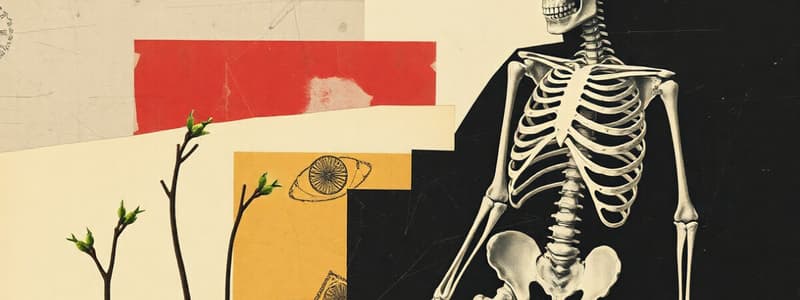Podcast
Questions and Answers
What is the first step in the process of bone healing?
What is the first step in the process of bone healing?
- Callus formation
- Bone remodeling
- Formation of a bony callus
- Hematoma formation (correct)
What type of tissue is formed during the second stage of fracture healing?
What type of tissue is formed during the second stage of fracture healing?
- Compact bone
- Spongy bone
- Cartilage only
- Fibrocartilage (correct)
Which part of the axial skeleton does NOT belong to the bony thorax?
Which part of the axial skeleton does NOT belong to the bony thorax?
- Vertebral column
- Sternum
- Ribs
- Clavicle (correct)
What occurs as the final step in the bone healing process?
What occurs as the final step in the bone healing process?
What is the primary structure of the axial skeleton?
What is the primary structure of the axial skeleton?
Which bone of the lower leg is larger and medially oriented?
Which bone of the lower leg is larger and medially oriented?
What forms the inner part of the ankle?
What forms the inner part of the ankle?
Which of the following statements about the fibula is true?
Which of the following statements about the fibula is true?
Which part of the tibia articulates with the femur to form the knee joint?
Which part of the tibia articulates with the femur to form the knee joint?
What is the role of the fibula in relation to the knee joint?
What is the role of the fibula in relation to the knee joint?
What are the primary curvatures of the vertebral column?
What are the primary curvatures of the vertebral column?
Which curvature forms an S-shape in adults?
Which curvature forms an S-shape in adults?
How many vertebrae comprise the cervical curvature?
How many vertebrae comprise the cervical curvature?
Which part is NOT a component of a typical vertebra?
Which part is NOT a component of a typical vertebra?
What is the number of thoracic vertebrae?
What is the number of thoracic vertebrae?
What is the characteristic shape of the spine in newborns?
What is the characteristic shape of the spine in newborns?
Which part of the vertebra is responsible for protecting the spinal cord?
Which part of the vertebra is responsible for protecting the spinal cord?
What type of curvature is the sacral curvature classified as?
What type of curvature is the sacral curvature classified as?
What structure is primarily responsible for the growth in length of long bones during childhood?
What structure is primarily responsible for the growth in length of long bones during childhood?
Which of the following is true regarding articular cartilage?
Which of the following is true regarding articular cartilage?
What occurs to cartilage at the epiphyseal plate as bones grow?
What occurs to cartilage at the epiphyseal plate as bones grow?
Which component of bone growth helps in the formation of a bone collar?
Which component of bone growth helps in the formation of a bone collar?
In which region does new bone most actively replace cartilage?
In which region does new bone most actively replace cartilage?
What is the significance of growth blood vessels in bone development?
What is the significance of growth blood vessels in bone development?
How does spongy bone differ from hyaline cartilage in terms of function?
How does spongy bone differ from hyaline cartilage in terms of function?
What happens to cartilage as a child matures and grows?
What happens to cartilage as a child matures and grows?
Which of the following is NOT a type of synovial joint shape?
Which of the following is NOT a type of synovial joint shape?
What is the primary function of bursae in synovial joints?
What is the primary function of bursae in synovial joints?
Which type of joint is classified as a biaxial joint?
Which type of joint is classified as a biaxial joint?
What is the role of a tendon sheath?
What is the role of a tendon sheath?
In a synovial joint, what type of cartilage covers the ends of the bones?
In a synovial joint, what type of cartilage covers the ends of the bones?
Which of these components is NOT considered part of a synovial joint?
Which of these components is NOT considered part of a synovial joint?
What type of joint allows for rotational movement around a single axis?
What type of joint allows for rotational movement around a single axis?
Which of the following statements about synovial joints is true?
Which of the following statements about synovial joints is true?
Flashcards are hidden until you start studying
Study Notes
Bone Growth and Remodeling
- Long bones grow in length due to cartilage growth at the epiphyseal plate
- Cartilage is replaced by bone at the epiphyseal plate
- Articular cartilage remains at the ends of the bones and doesn't get replaced by bone
- Growth in bone width is achieved by bone forming on the outside of bone (periosteum)
- Bone remodeling occurs throughout life and involves bone resorption and deposition
- Bone remodeling is influenced by hormones, physical activity, and diet
- During bone repair, a hematoma forms at the fracture site
- Fibrocartilage callus forms after the hematoma
- Bony callus forms replacing the fibrocartilage callus
- Bone remodeling occurs to remodel the bony callus into mature bone
Bone Fractures
- Bone fractures are breaks in the bone
- Common types of fractures include simple, compound, comminuted, and greenstick fractures
Axial Skeleton
- The axial skeleton forms the longitudinal axis of the body
- The axial skeleton is divided into the skull, vertebral column, and bony thorax
Vertebral Column (Spine)
- There are 33 vertebrae in the vertebral column, including 24 presacral and 9 sacral vertebrae
- The primary spinal curvatures are in the thoracic and sacral regions
- Primary spinal curvatures are present at birth
- Secondary spinal curvatures are in the cervical and lumbar regions
- Secondary spinal curvatures develop after birth
- Each vertebra consists of a body, vertebral arch, vertebral foramen, transverse processes, spinous process, and superior and inferior articular processes
Bones of the Lower Limbs
- The lower leg has two bones: the tibia (shinbone) and fibula
- The tibia is larger and medially oriented
- The fibula is thin and sticklike and lateral to the tibia
- The distal end of the tibia forms the medial malleolus, which forms the inner part of the ankle
- The distal end of the fibula forms the lateral malleolus, which forms the outer part of the ankle
Joints
- Synovial joints are freely movable joints
- Synovial joints are characterized by the presence of a joint cavity, articular cartilage, synovial membrane, and articular capsule
- The joint cavity is filled with synovial fluid, which lubricates the joint and reduces friction
- Bursae are flattened fibrous sacs that are lined with synovial membranes and filled with synovial fluid
- Tendon sheaths are elongated bursae that wrap around tendons
- Types of synovial joints are classified based on shape: plane, hinge, pivot, condylar, saddle, and ball-and-socket
- Plane joints allow for gliding movement
- Hinge joints allow for uniaxial movement, such as flexion and extension
- Pivot joints allow for uniaxial rotation
- Condylar joints allow for biaxial movement, such as flexion, extension, adduction, abduction
- Saddle joints allow for biaxial movement, such as flexion, extension, adduction, abduction, and circumduction
- Ball-and-socket joints allow for multiaxial movement, such as flexion, extension, adduction, abduction, rotation, and circumduction
Studying That Suits You
Use AI to generate personalized quizzes and flashcards to suit your learning preferences.




